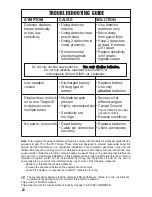
This metal detector is intended for locating buried metal objects. When
searching for metals, underground or on the surface, you have the following
challenges and objectives:
1. Ignoring signals caused by ground minerals.
2. Ignoring signals caused by metal objects that you do not want to find, like
nails.
3. Identifying a buried metal object before you dig it up.
4. Estimating the size and depth of objects, to facilitate digging them up.
5. Eliminating the effects of electromagnetic interference from other
electronic devices.
Your metal detector is designed with these points in mind.
1. Ground Minerals
All soils contain minerals. Signals from ground minerals can interfere with
the signals from metal objects you want to find. All soils differ, and can differ
greatly, in the type and amount of ground minerals present. You therefore
want to “calibrate” the detector to the specific ground conditions where you
are hunting. The detector incorporates both automated and manual ground
cancelation features which will eliminate false signals caused by most types
of soils. If you want to maximize the detector's target identification accuracy
and depth of detection, use the GROUND GRAB
®
Computerized Ground
Cancelation function to calibrate the detector to the ground where you are
searching. See the section on Ground Cancelation for details.
2. Trash
If searching for coins, you want to ignore items like aluminum foil and nails.
You can see the Target-ID value of the buried objects, listen to the sounds
and then decide what you want to dig up. Or you can eliminate unwanted
metals from detection by using the DISCRIMINATION feature.
3. Identifying Buried Objects
Metal objects are identified by a 2-digit number on the display screen. This scale
has 99 points of resolution, and is an indicator of the relative electrical
conductivity of different objects. Higher numbers indicate more conductive
targets. Iron objects, which are usually of lesser value, display lower
numbers. Silver coins, for instance, usually display the highest numbers.
4. Size and Depth of Buried Objects
The 5-segment target depth indicator shows the relative depth of a buried
metal object.
This bar graph can indicate the relative size of different objects or their
distance from the searchcoil. For a given object, the more distance between it
and the searchcoil, the more bars illuminated. A more accurate, and higher
resolution, depth reading is available when using Pinpoint. Pinpoint does not
require the searchcoil to be in motion to detect metals. The ability to hold the
searchcoil motionless over the target also aids in tracing an outline of the
buried object, or in pinpointing the exact location of the object using
techniques described in the pinpointing section of this manual.
8
THE BASICS OF METAL DETECTING









































